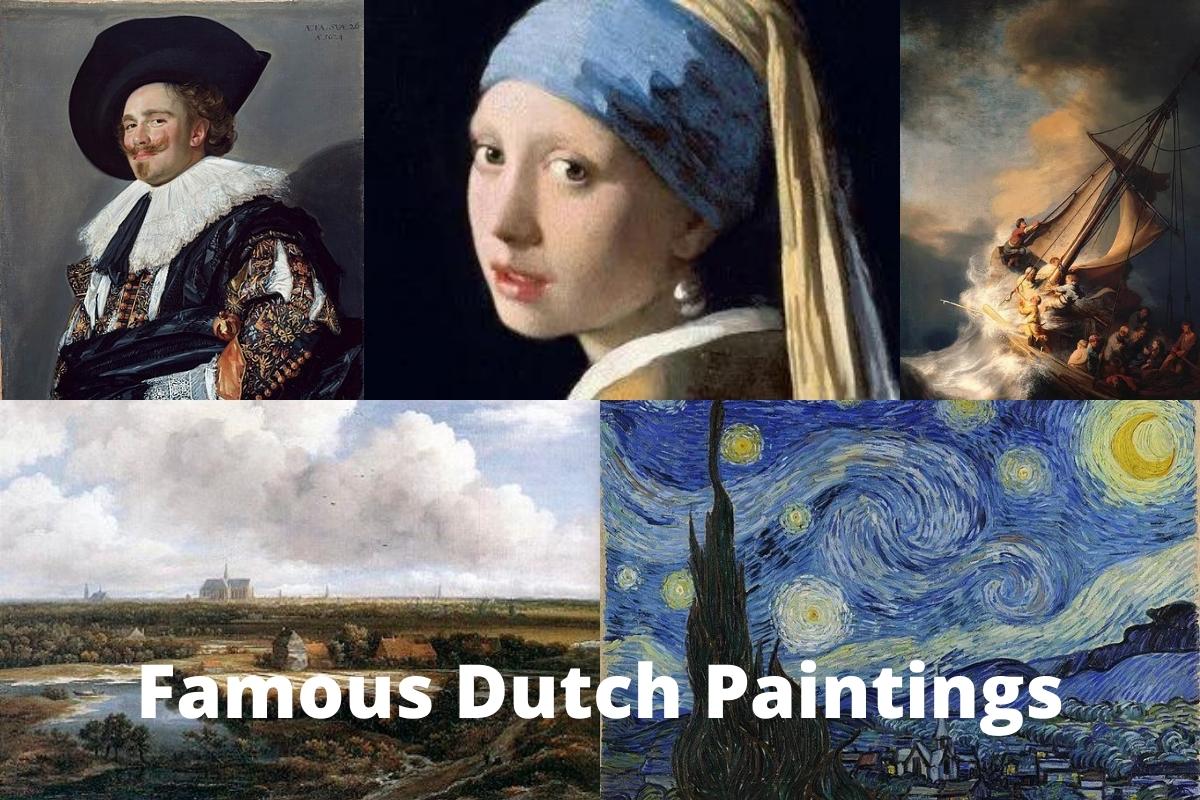Dutch painting is the history of visual arts in the Netherlands after the separation of the United Provinces from Flanders. Early Netherlandish painting and Dutch and Flemish Renaissance art cover earlier painting in the region.
The history of Dutch art is dominated by Dutch Golden Age painting, which lasted from roughly 1620 to 1680 and saw the development of a unique style and new genres of painting while yet maintaining strong ties with Flemish Baroque painting.
During the seventeenth century, there existed a flourishing artistic atmosphere in Dutch towns. Between 1605 and 1635, for example, nearly 100,000 paintings were created in Haarlem.
At the time, the city’s art ownership rate was 25%, a record high. After the end of the Golden Age, the output of paintings remained high, but it lost its clout throughout the rest of Europe.
Many seventeenth-century painters, sculptors, and builders are referred to as “Dutch masters,” but earlier artists are often considered to be part of the “Netherlandish” school.
The labeling or cataloguing of an individual piece as “Dutch School” without additional attribution suggests that a particular artist for the work cannot be identified.
The Hague School of the nineteenth century reinterpreted the Golden Age’s breadth of topics in current terms, reestablishing Dutch painting as a European leader.
The Dutch contribution to succeeding movements of art during the nineteenth century has been most recognized via the work of particular personalities such as Vincent van Gogh and Piet Mondrian, albeit both created their greatest work outside the Netherlands and required some time to be acknowledged.
Famous Dutch Paintings
1. The Starry Night – Vincent van Gogh
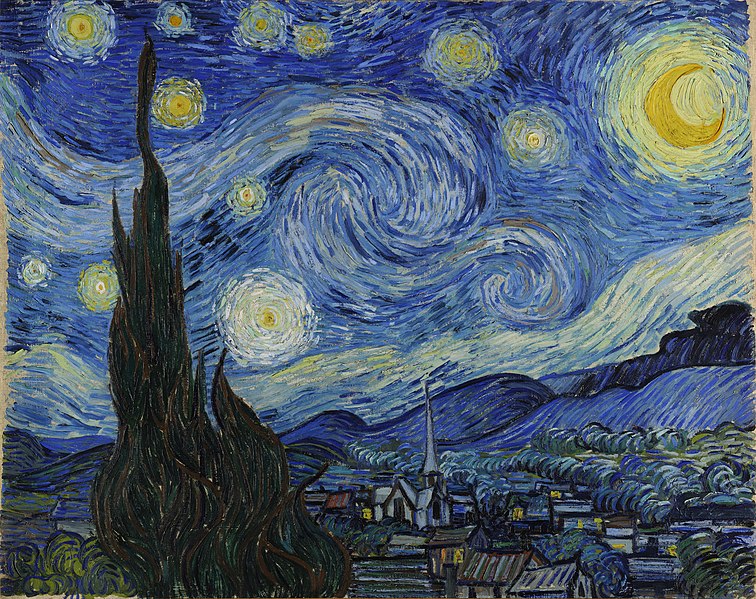
There is no doubt among art critics and historians that Vincent van Gogh’s iconic painting The Starry Night is one of the most universally admired paintings ever created by a Dutch artist.
Throughout his brief life, Van Gogh was equally skilled and psychologically tormented. Van Gogh was born in 1853, and his art would become more well-known after his death 37 years later.
The Starry Night is a vast representation of the moon and stars spread out above the little hamlet of Saint-Rémy-de-Provence in France, and is regarded one of the most famous paintings of the century. Van Gogh is claimed to have seen this vista from the window of his institution around a year before his death.
Van Gogh painted multiple variants of the same landscape, each with its own brushstroke qualities that gave it its own personality.
The most popular form is notable for its circular brush strokes and broad, sweeping brush strokes. This was one of van Gogh’s rare nocturne paintings, and it is often regarded as the most memorable and renowned of all time.
2. The Storm on the Sea of Galilee – Rembrandt van Rijn
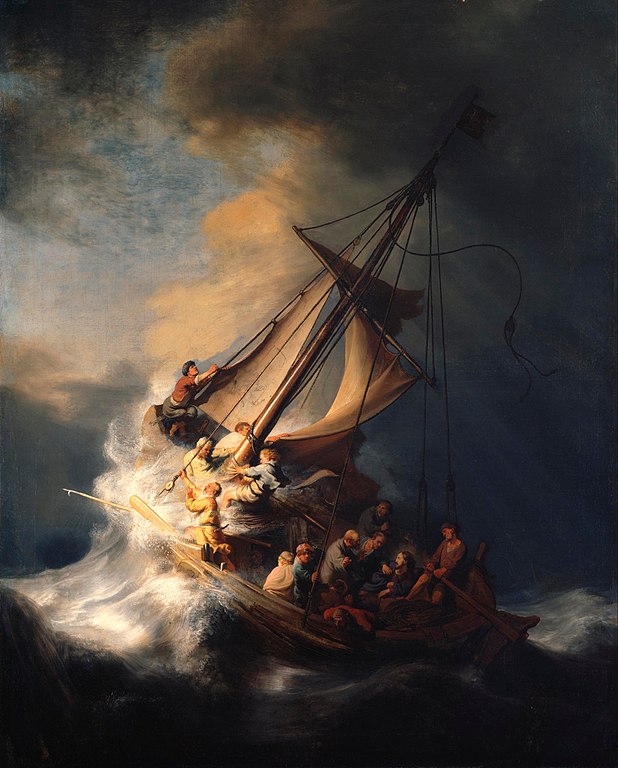
While on exhibition at Boston’s Isabella Stewart Gardner Museum, Rembrandt’s lone seascape, The Storm on the Sea of Galilee, was tragically stolen by an organized criminal ring.
The image depicts Jesus calming the storm on the Sea of Galilee, as described in Mark’s fourth chapter.
The artwork’s vertical style displays a close-up view of Christ’s disciples urgently trying to regain control of their fishing boat in the midst of a violent storm.
Also Read: Rembrandt Most Famous Paintings
The bow is thudded by a tremendous wave, which shreds the sail. One of the disciples is seen vomiting on the building’s side. Another is a self-portrait of the artist with his or her back to the viewer. Only Christ, who is shown on the right, keeps his cool.
The artwork is included in the Netflix series This Is a Theft: The World’s Greatest Art Heist, which is a four-part documentary miniseries that premiered in 2021 about the robbery of the Isabella Stewart Gardner Museum on March 18, 1990.
3. Girl with a Pearl Earring – Johannes Vermeer
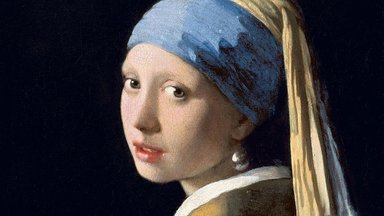
Vermeer painted one of the most famous portraits of all time in 1665. The oil painting portrays a young girl with an alluring look gazing back at the viewer, piquing the curiosity of people who have the pleasure of seeing this work.
The painting is known for its incredible realism and Vermeer’s ability to depict minute variations in light and shadow.
The girl’s eyes are one of the most interesting parts of the painting, according to art experts and connoisseurs, since they are fastened on the observer in a hilarious and anticipatory way.
Rather than just exposing her profile to the onlooker, the young woman peers over her shoulder with a questioning expression.
The subtle color combinations and contrast between light and shadow lead to this painting’s status as the most renowned Vermeer painting.
4. The Laughing Cavalier – Frans Hals
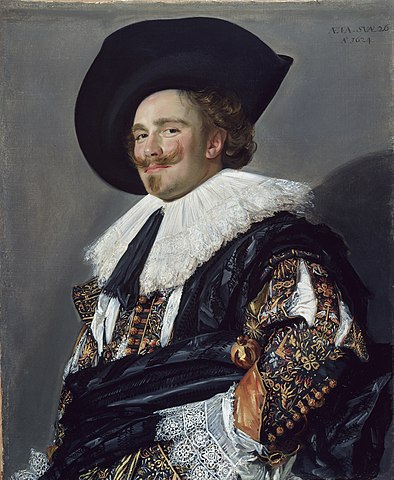
The Laughing Cavalier (1624) is a portrait in the Wallace Collection in London by Dutch Golden Age painter Frans Hals, hailed as “one of the most beautiful of all Baroque portraits.”
The title is a creation of the Victorian public and press, dating from its exhibition in the Bethnal Green Museum’s opening exhibition in 1872–1875, shortly after its arrival in England, after which it was regularly reproduced as a print and became one of Britain’s most well-known old master paintings.
The unidentified man isn’t laughing, but he does have an intriguing grin, which is accentuated by his tilted mustache.
Though the man’s recorded 19th-century titles mostly suggest a military man, or at least an officer in one of the part-time militia companies that were frequently the subjects of group portraits, including some by Hals and later Rembrandt’s Night Watch (1642), he was just as likely to be a wealthy civilian.
5. Netherlandish Proverbs – Pieter Bruegel the Elder
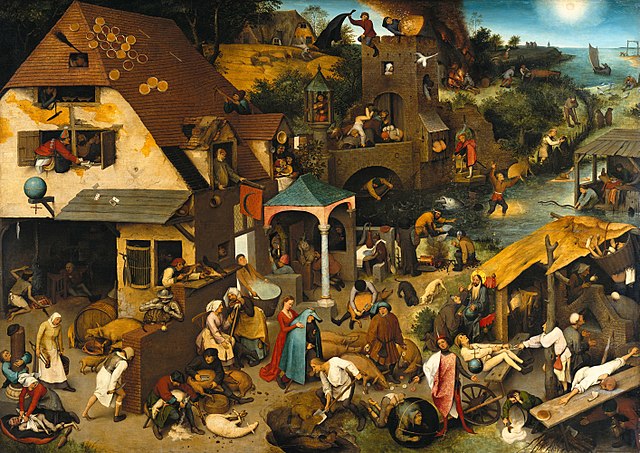
Netherlandish Proverbs is a 1559 oil-on-oak-panel painting by Pieter Bruegel the Elder depicting a scenario in which people, animals, and objects, to a lesser degree, provide realistic representations of Dutch-language proverbs and idioms.
The folly, immorality, and ignorance of people are recurring themes in Bruegel’s paintings that occur in Netherlandish Proverbs. Its original title, The Blue Cloak or The Foolishness of the World, suggests that Bruegel’s intention was to record human folly rather than only depict proverbs.
Many of the persons pictured have Bruegel’s signature blank faces, which he employed to represent idiots.
Pieter Brueghel the Younger, his son, specialized in replicating his father’s work and painted at least 16 reproductions of Netherlandish Proverbs. Not all copies of the artwork, whether by the father or the son, depict the same proverbs, and they vary in other small elements as well.
6. View of Haarlem with Bleaching Fields – Jacob van Ruisdael
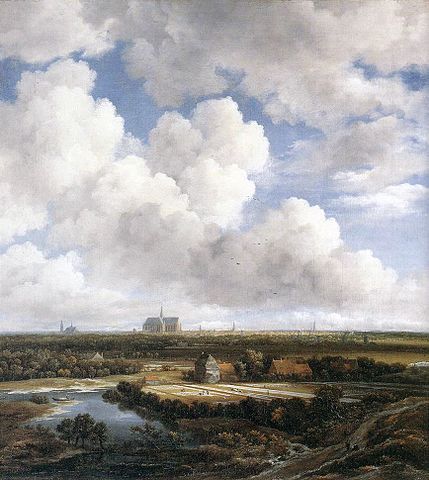
Jacob van Ruisdael painted an oil on canvas painting called View of Haarlem with Bleaching Fields. It is a painting from the Dutch Golden Age that is currently in the Kunsthaus Zürich’s collection.
Also Read: Famous Poppy Paintings
A marshy pool surrounded by trees can be seen in the left foreground. From there, a road runs up a hill to the right backdrop. Part of the bleaching grounds can be seen in the distance; enormous pieces of linen are stretched out near cottages, and many people are at work.
The town of Haarlem, dominated by the church of St. Bavo, can be seen in the distance. Large clouds blanket the sky, casting a shadow over practically the whole terrain; stray sunbeams illuminate parts of the town and the bleaching grounds.
7. Self-portrait by Judith Leyster – Judith Leyster
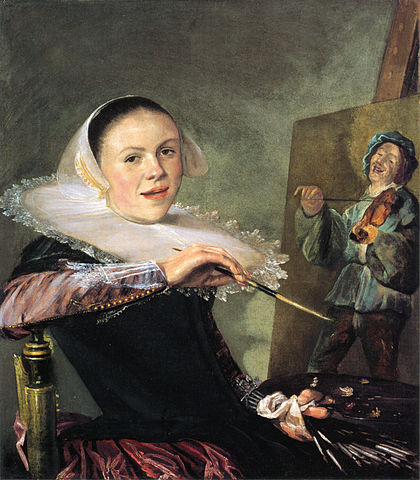
Self-portrait by Judith Leyster is an oil painting from the Dutch Golden Age that is presently at the National Gallery of Art in Washington, DC.
It was presented to the Haarlem Guild of St. Luke in 1633 as a masterpiece. It had been credited to Frans Hals for centuries, but it was only until the museum acquired it in 1949 that it was legitimately assigned to Judith Leyster. The style is similar to that of Haarlem’s most renowned portraitist, Hals.
A second self-portrait, dated from roughly 1653, was discovered in 2016.
Despite the fact that Leyster seems to be at ease, the composition is quite contrived. She is dressed in what must have been her nicest clothing, which she would not have risked coming into contact with wet oil paint in the first place.
The figure she’s painting comes from another piece, and it’s possible it was never painted as a single figure.
8. River Landscape with Riders – Aelbert Cuyp
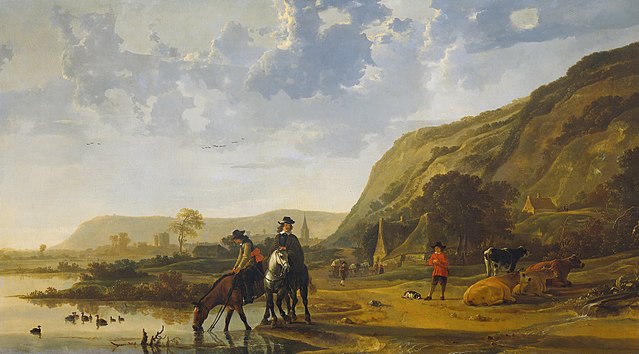
Aelbert Cuyp’s painting River Landscape with Riders, c.1653–1657, is presently at the Rijksmuseum in Amsterdam, which purchased it in 1965 from the Edmond de Rothschild collection in Exbury, Hampshire.
A broad, sun-drenched river scene with airy painted clouds in the background. Two Dutch policemen come to a halt alongside a shepherd and his resting sheep by the river to water their horses.
It depicts two riders pausing by a river to allow their horses to drink, as the title suggests. The hilly scene is based on those found along the Rhine between Nijmegen and Kleve, a location Cuyp visited and drew in 1652, and from which he prepared landscape sketches that he transported back to his Dordrecht workshop.
A broad, sun-drenched river scene with airy painted clouds in the background. Two Dutch policemen come to a halt alongside a shepherd and his resting sheep by the river to water their horses.
9. The Potato Eaters – Vincent van Gogh
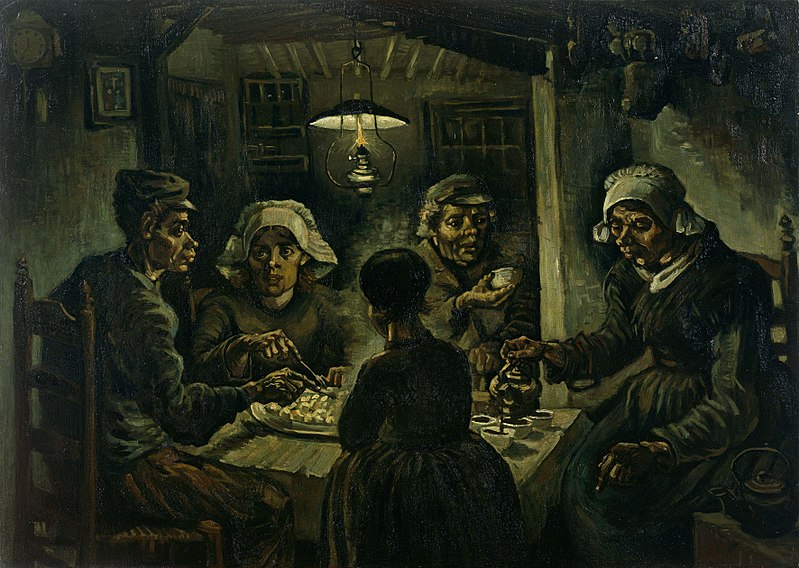
The Potato Eaters is an oil painting that was done in Nuenen, Netherlands, in April 1885. The painting’s original oil sketch is on exhibit at Otterlo’s Kröller-Müller Museum, and he also produced lithographs of the image.
The Potato Eaters is a deliberate attempt by a young artist to establish himself in the world. Before making a mature figure piece, he would make multiple preliminary drawings and lithographs in order to develop his technique.
A picture of five seated persons in a small dark space dimly lit by an oil lamp needs a significant deal of skill to execute well.
Between April 13 and the beginning of May, Van Gogh completed the ‘real’ painting. He painted The Potato Eaters on a much larger canvas.
Unlike the previous oil and charcoal drawings, this one was ‘mostly from memory,’ which is a true testimonial to an artist’s talent.
10. The Happy Family – Jan Steen
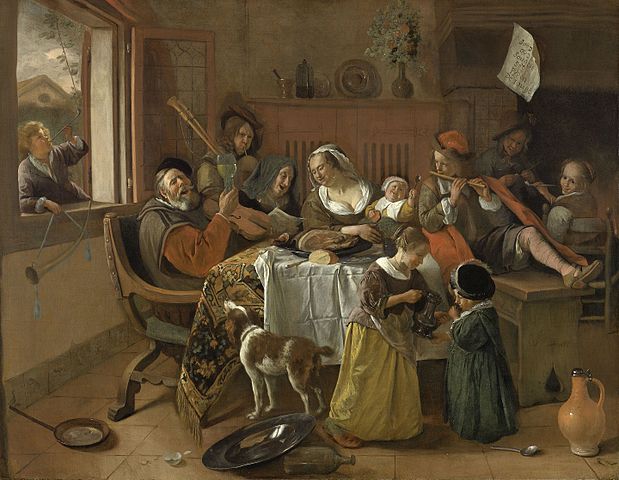
Jan Havickszoon Steen was a Dutch Golden Age painter who was regarded as one of the most important genre painters of the period. His paintings are noted for their psychological insight, wit, and use of color.
Jan Steen’s oil work The Happy Family or As the Old Sing, So Shall the Young Pipe was completed in 1668. It is presently on display in Amsterdam’s Rijksmuseum.
The artwork shows a joyous family dinner in which the family patriarch is in full voice, backed up by the mother and grandmother, thanks to huge quantities of alcohol. On musical instruments, the kids join in.

